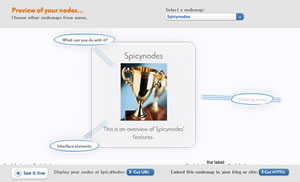 Spicynodes is a new web-based mind mapping tool developed by the Institute for Dynamic Educational Advancement (IDEA) that aims to help organizations to create a more “humane,” usable interface for navigating large amounts of information, such as a website or a small company knowledgebase.
Spicynodes is a new web-based mind mapping tool developed by the Institute for Dynamic Educational Advancement (IDEA) that aims to help organizations to create a more “humane,” usable interface for navigating large amounts of information, such as a website or a small company knowledgebase.
SpicyNodes features slick Flash-based animation that “flies” you through information as you click on nodes to expand their child topics. The effect is something like navigating deeper into a PersonalBrain map, where each click causes the map to reposition itself, with the currently-selected node as the focal point.
One neat interface element gives users a “preview” of what’s connected to a topic before expanding it to view its children. Say, for example, a topic has 3 sub-topics. The topic is displayed with 3 small circles next to it; mousing over each one causes a tooltip to pop up, effectively giving you a “sneak peek” at the content below it in the map hierarchy. Also, unlike traditional mind mapping applications, where expanding a topic opens up all of its sub-topics, you can click on one circle and only expand that section of the map, or on the topic itself, which expands the view to include all connected sub-topics. I found this to be very convenient!
When viewing a map, you can utilize keyboard commands to move around it. SpicyNodes not only provides a map zoom command, but also a focus slider tool, which changes the size of the currently selected topic or node relative to the others in the map. Topics can contain links, which makes it possible to embed a SpicyNodes map into your website as a navigation element, while “previous” and “next” buttons enable you to make presentations using a SpicyNodes map; clicking either button walks you through your map, one topic and sub-topic at a time.
Creating a new map was a little more challenging, however. When you first create a new map, you’re asked to give it a title and description. Curiously, the title isn’t used as the text of the central map topic. Also, once you’ve given your new map a name, the next step in the map wizard is to set its style. Are you kidding? I’m not even quite sure what I’m creating yet! It seemed a little premature as part of the map development workflow, and left me puzzled as to how to get myself out of the styles area. Still, I was intrigued by some of the well-designed map styles that Spicynodes offers. I finally discovered a set of tabs above it that enable you to “edit details,” “edit style” and “edit content.”
To edit your map’s content, SpicyNodes displays a hierarchical outline of a blank main topic and 3 sub-topics, waiting for me to add topic text. At first, I found this to be disconcerting, because I’m used to editing map topics directly in the map view. But after I got used to it, I actually found it to be an efficient interface design. In other words, it didn’t take up much space on the screen and provided me with a common-sense framework for adding content to my map.
By default, the application shows a simplified view that only lets you add or edit topic text, delete the current topic or add a child topic. But clicking an “edit details” button opens up a variety of other options, including the ability to add images, web page links and YouTube videos. At any time, you can click on a “preview” button to see what your map looks like.
The edit style tab provides an extensive set of options for customizing everything, including text fonts, color schemes, connector and topic shapes, map layout and even accessibility options (for users with color blindness). Very impressive!
Spicynodes offers several options for importing and exporting maps. You can import a text or XML file to use as a the starting point for a new map, and export to both formats as well.
Overall, this looks like a promising web-based mind mapping application. While it’s feature set is still a bit on the light-weight side, Spicynodes incorporates some unique and intriguing styles and interface elements. I can’t wait to see where they take it from here!

Leave a Reply